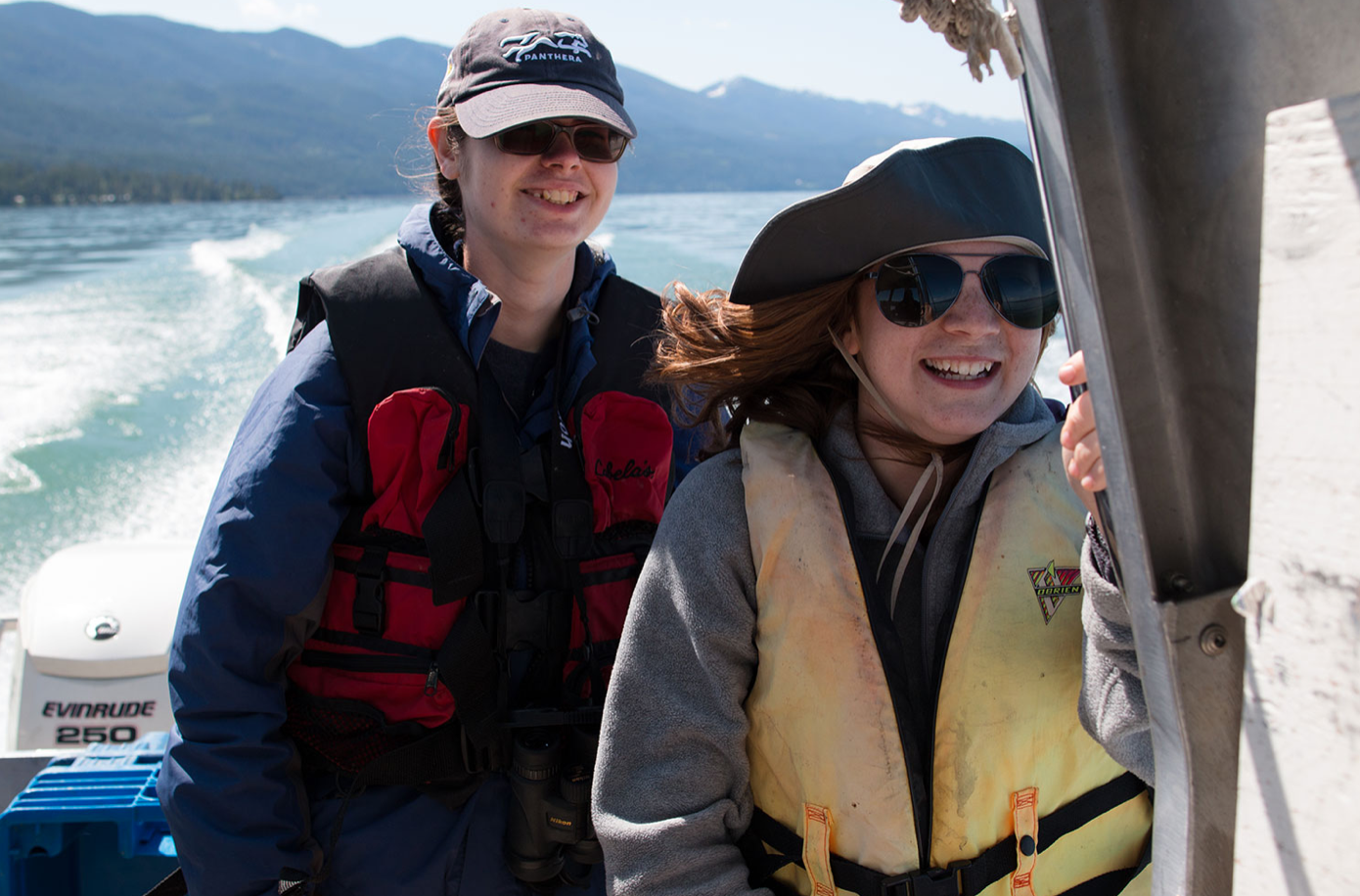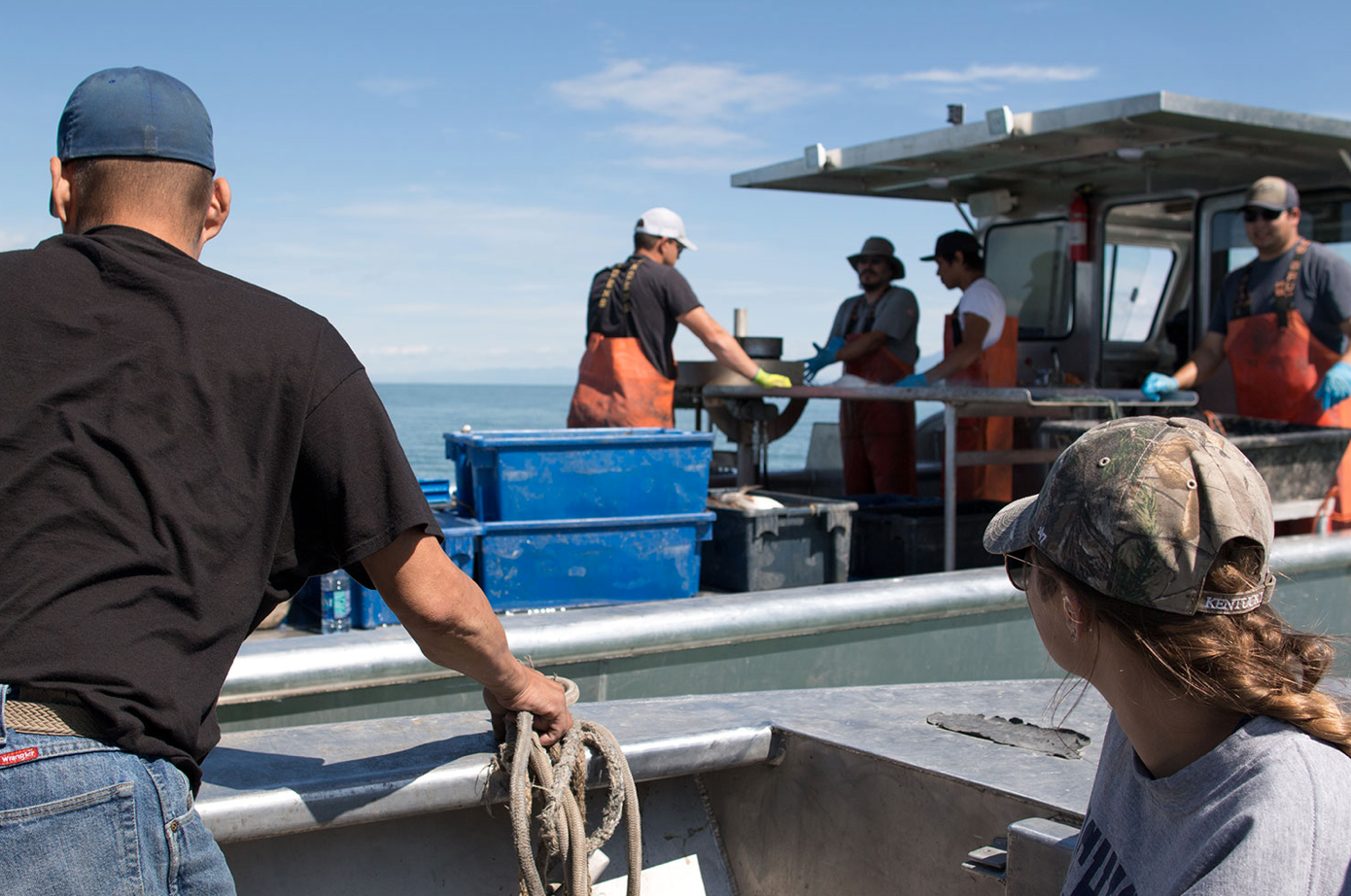Restoring Watersheds with the Confederated Salish and Kootenai Tribes
By Rob Rich
June 8. 2018
Students experience the wetlands of Mission Creek from all angles with CSKT Biologists Rusty Sydnor (pictured) and Craig Barfoot. By slowing, storing, and filtering the flow, wetlands like these are a foundation of watershed health in the Mission Valley.
More than a few eyebrows perked up when Biologist Rusty Sydnor called something on the landscape a “wasteway.” Our Wildlife in the West students were on tour in the Mission Valley, to learn from the Confederated Salish and Kootenai Tribes (CSKT) about managing watersheds and native fish. Listening to Sydnor from a blufftop perch, one might have termed the topography in question a drainage or creek, but the word wasteway seemed to tend the wrong direction. But for a long time, that’s just where the Moeise Wasteway flowed. Along with the adjacent Coleman Coulee, these catchments-cum-sacrifice zones had carried tons of tons of excess nutrients, sediments, and fertilizers shed from the irrigated lands with erosion-prone soils on the Flathead Indian Reservation near the National Bison Range. So many tons that, as the slurries dumped into Mission Creek, they stained the water with a signature of silt that carried for miles.
Thankfully, that’s not the end of the story. Given that native people have valued this region’s native fish and flora for a millennia, CSKT was not about to let their watershed health degrade that far into the future. Their answer? One of nature’s most effective, time-tested tools: wetlands. Beginning in the 2007, with a grant from the Environmental Protection Agency and Bonneville Power Administration habitat mitigation funds, CSKT planned and accomplished a project that restores the filtering, absorbing functions to Mission Creek’s old oxbows and densely vegetated off-channel habitats. With baffling “before” pictures in hand, Sydnor and fellow Biologist Craig Barfoot proudly showed off what’s changed: instream work restoring Mission Creek to its former channel (adding over 2,000 feet of water-slowing curves), better livestock and irrigation management practices, and a “wasteway” that now flows near-clear after its weave through 13 acres of constructed wetlands. These sponge-like habitats teemed with native species of rush, sedge, and grass – to the direct benefit of the trout who depend on the clear, cold water they provide. Confirmed by the banter of soras and blackbirds (both yellow-headed and red-winged), we could not help but be awed at these profound instances of re-creation, still improving eleven years out.
The tour de force continued as Barfoot highlighted an additional project on the Jocko River, near Arlee. After supporting landowners to remove more than 20 buildings from the floodplain, the Jocko – once incised and constricted – was returned to the sinuous channels of its past, now free to lasso about in a channel that is delightfully complicated with woody debris. Barfoot and Sydnor highlighted the revegetation of the erosive banks too, including trees planted and others naturally regenerating, especially that beacon of the West’s flowing waters: the black cottonwood.
Tired but inspired, camp talk that night at Big Arm State Park was animated by the persisting curiosities of the day, with intervals for field journaling and tasty culinary experiments that involved fire, tin foil, vegetables, and bison meat. S’mores followed, then a clear starry night, and before we knew it were off in the morning to Blue Bay, on the east side of Flathead Lake. We were to meet with another CSKT Fisheries Biologist, Barry Hansen, to explore CSKT’s lake restorations, which are necessarily different from healing rivers, wetland, or creeks. And though Flathead Lake is actually one of the cleanest large waterbodies of its kind in the world, it still has issues. Chief among them is the non-native lake trout that’s been consuming a lot of Hansen’s time and effort, and the native fish he’s charged to protect.
With an enormous reproductive potential and even bigger appetite, lake trout is threatening native bull and westslope cutthroat trout regionwide wherever they have been (illegally) introduced throughout the region. But we’ve been learning that management schemes differ widely by place and politics, and the two-pronged approach on the southern half of Flathead Lake – where CSKT works – stands in a class of its own.
The first aspect includes a series of incentivized lake trout fishing contests, called Mack Days (“mackinaw” is one of the lake trout’s nicknames). With categories for the biggest fish, smallest fish, most fish, and more – across genders and age brackets from kids to seniors – Mack Days has reeled in gargantuan numbers of lake trout since its start in 2011, including over 30,000 so far this year. But CSKT’s second approach, a commercial lake trout fishery, is equally novel. Such operations were once common across the Great Lakes where these trout are native, but in the West it’s uncommon to save native fish by making sure the usurping predator doesn’t get the last meal. For several years CSKT solely caught lake trout for donation to food banks, but to help offset Mack Days’ extensive prize monies, CSKT is now complementing that service with online sales through their non-profit, Native Fish Keepers, Inc.
We not only got the chance to visit the state-of-the-art facility where CSKT filets, packs, and freezes their fish, but we also helped Hansen’s team to deliver them from net to boat to the processing tables. Spending a morning steeped in the smell of fresh fish was a sharp contrast from the lupine-rich scents our noses have been used to this week, but it was more than worth the opportunity to see a one of a kind, tribally owned and operated enterprise in action. While not all people agree with CSKT’s approach to lake trout suppression, there’s no doubt they take their stewardship seriously. The experience pushed our thinking down the right paths, where there will never be wasteways again.
Gabby and Meghan enjoy the ride out to meet to meet the lake trout fishermen.
Bridget and crew prepare to pick up the day’s catch.




